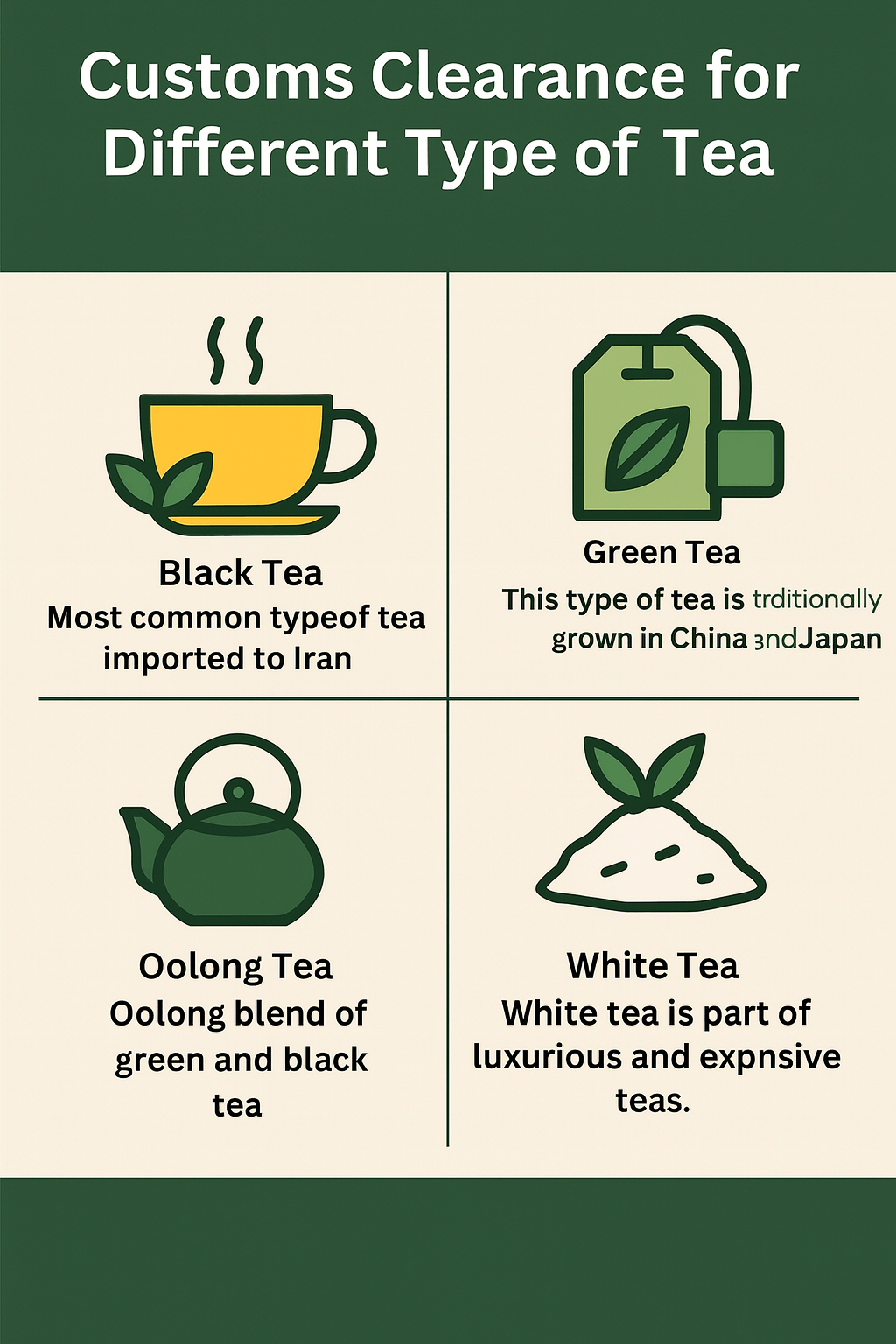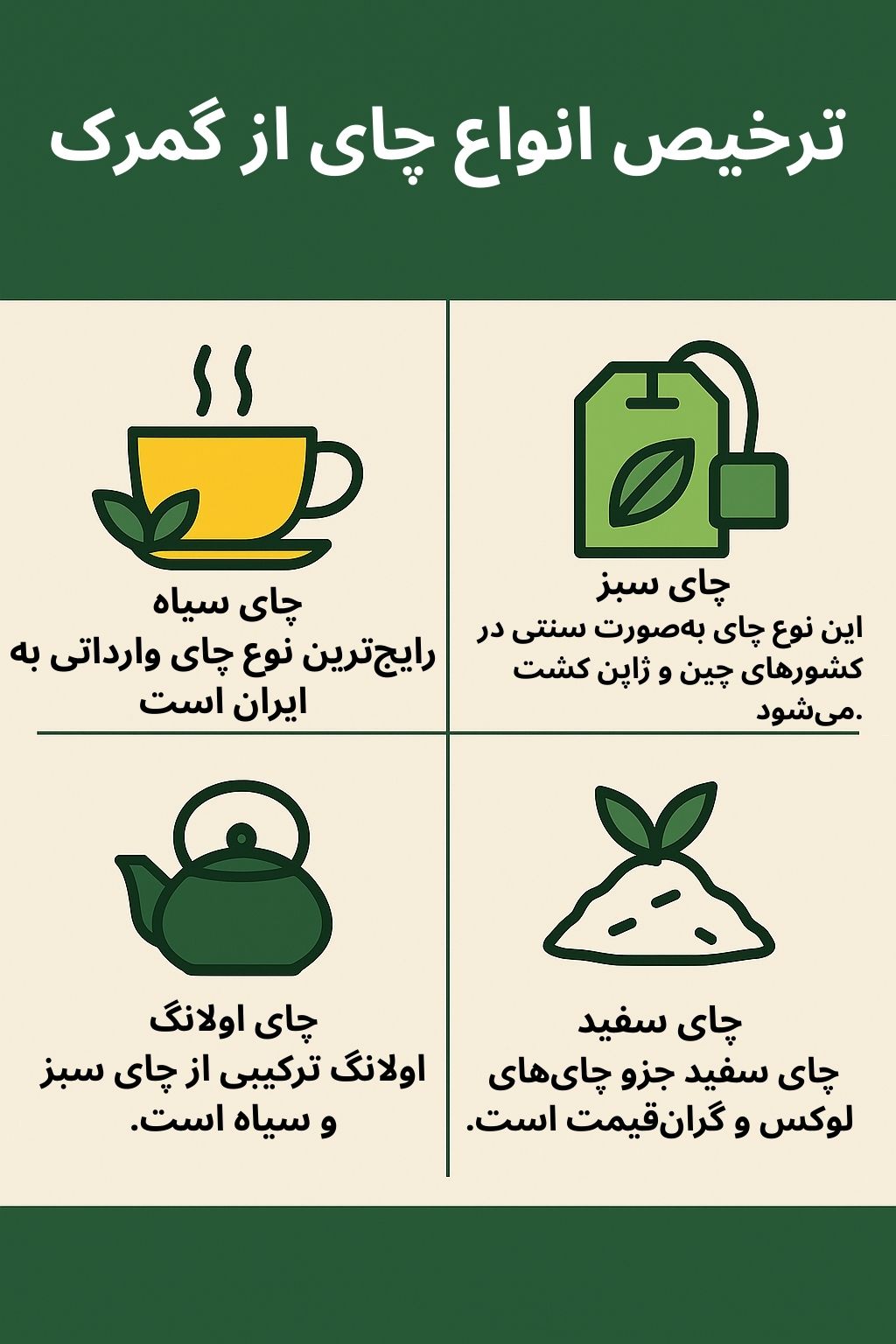Customs Clearance of Various Teas
To estimate the time and cost of tea clearance, contact the experts at Saba Tarkhis.
Immediate Free Consultation
1) Types of Tea Imported into Iran
-
Black Tea: Black tea accounts for the largest share of tea imports into Iran. This type of tea is imported from major countries such as India, Sri Lanka, and Kenya. Due to its strong flavor and public preference, black tea is highly popular in the Iranian market.
-
Green Tea: Owing to its therapeutic and health benefits, green tea has gained many fans in Iran in recent years. This type of tea is mainly imported from China and Japan and requires stricter health inspections and specific standards for entry into Iran.
-
Oolong Tea: A combination of green and black tea with different properties and flavor. Oolong tea is mostly imported from China and has a specific audience in Iran.
-
White Tea: White tea is among the rarest and most expensive types of tea, predominantly imported from China. Due to its special processing and unique properties, it is usually considered a luxury product.
2) Customs Tariffs and HS Codes for Tea
Each type of tea imported into Iran is classified under a specific tariff code (HS Code). These codes directly affect customs tariffs and import-related costs. Accurate knowledge of these codes helps importers know the costs and tariffs before goods are declared to customs.
| Type | Description | HS Code |
|---|---|---|
| Black Tea (non-flavored) | Without added flavoring | 09024010 |
| Flavored Black Tea | Containing flavoring | 09024020 |
| Green Tea (non-fermented) | Non-fermented | 09021000 |
Tariff rates may be updated due to changes in trade/economic rules; check the latest regulations before declaration.
3) Key Steps and Considerations in Tea Customs Clearance
Need an exact HS Code and health-permit guidance? Our team manages the case end-to-end.
Submit Proforma Request4) Special Conditions for Tea Import and Export
Tea imports into Iran: Iran is one of the largest tea consumers in the Middle East, and due to this high demand, the annual volume of tea imports is considerable. Countries such as India, Sri Lanka, Kenya, China, and Japan are among the biggest tea exporters to Iran. Among these, black tea accounts for a major share of imports—more than 80% of Iran’s total tea imports. Green tea and other types such as oolong and white tea have also seen increasing demand in recent years and have captured a notable share of Iran’s consumer market.
Tea exports from Iran: Iran itself is also a tea producer, especially in the northern regions such as Gilan and Mazandaran. Owing to its quality and unique flavor, Iranian tea is exported to neighboring countries including Iraq, Afghanistan, Turkmenistan, and others. Although the volume of Iran’s tea exports is lower than its imports, Iranian tea exports still attract foreign markets due to the product’s natural and traditional characteristics. Enhancing quality and production standards has turned Iranian tea into a desirable product in regional markets.
5) Tea Import and Export Volumes for Iran
Based on recent statistics, around 70 to 100 thousand tons of tea are imported into Iran annually, mostly sourced from India and Sri Lanka. A major share of this amount is black tea, which has the highest consumption in Iran’s domestic market. By contrast, Iran’s tea exports stand at about 10 thousand tons per year, and given the high quality of local tea, this figure is expected to grow in the coming years.
6) Global Turnover of Tea
The financial turnover of the global tea industry reaches billions of dollars. According to international reports, the global tea market in 2022 was valued at over 200 billion dollars and continues to grow. With rising tea consumption in developing countries and increasing demand in European countries and the United States for specialty teas such as green and oolong, this market is expected to see significant growth in the coming years.
7) Major Tea Exporters and Importers Worldwide
Major tea exporters worldwide: India — the largest tea producer and exporter in the world, shipping a wide variety of teas, especially black tea, to global markets. China — a major producer of green and white tea and one of the primary exporters of high-quality teas worldwide. Sri Lanka — one of the leading producers of black tea, accounting for a significant share of black tea exports. Kenya — renowned especially for black tea production and a key supplier to international markets.
Major tea importers worldwide: European Union — the largest tea importer globally, particularly for green and specialty teas. United States — one of the largest tea consumption markets, with rapid growth in imports of green and oolong teas. Russia — with high consumption of black tea as a staple drink, importing large volumes from India and Sri Lanka. Pakistan and Egypt — among the largest tea importers in the Middle East and South Asia, mostly dependent on black tea.

8) Required Documents for Tea Customs Clearance
-
1. Bill of Lading The bill of lading is issued by the carrier and includes information such as the type of goods, weight, origin and destination, and carrier details. It is required as proof of shipment identification and ownership.
-
2. Commercial Invoice The commercial invoice includes the purchase details. It must contain the seller’s and buyer’s names, date of sale, exact product specifications, unit price, and total amount. It serves as the primary document to determine the customs value.
-
3. Packing List The packing list details the shipment: number of packages, weight per package, and specifications of each tea type (type and volume). It helps customs perform accurate inspections.
-
4. Certificate of Origin The certificate of origin confirms the country where the goods were produced. Usually issued by the chamber of commerce or similar bodies, it may be necessary to use preferential tariffs where applicable.
-
5. Health Certificate Importing tea into Iran requires a health certificate from the Food and Drug Administration. This confirms the tea complies with sanitary standards and is free from harmful substances.
-
6. Certificate of Quality Usually issued by accredited laboratories, it confirms that imported tea complies with specified quality standards, including test results and quality specifications.
-
7. Certificate of Conformity This certificate verifies compliance of the imported tea with national and international standards. It is typically mandatory for sensitive goods such as food and pharmaceuticals.
-
8. Other Documents Depending on specific conditions and tea type, additional documents may be required. For example, when tea is imported from specific regions or under special conditions, extra permits from relevant government bodies may be necessary.
Frequently Asked Questions
What are the main HS Codes for tea?
Non-flavored black tea 09024010, flavored black tea 09024020, and green tea (non-fermented) 09021000. The exact heading may vary by form of presentation/additives.
What permits are required to import tea?
Health permits from the Food and Drug Administration, quality/conformity certificates, and other special permits where applicable. Laboratory sampling may be performed.
What is Iran’s tea import volume?
Annually about 70 to 100 thousand tons; mainly from India and Sri Lanka, largely black tea.
Special Tea Clearance Services by Saba Brokerage
Specialized pre-clearance consulting: Our experts, fully aware of the latest customs and sanitary regulations, provide the necessary guidance to tea importers. This includes a thorough review of customs tariffs, HS Codes, and required documents to prevent any issues or delays during clearance.
Continuous and swift customs follow-up: Using an extensive network of connections in customs offices, all stages of obtaining health permits and required standards are pursued quickly and accurately. These permits include approvals from the Food and Drug Administration and accredited laboratories, which are mandatory for tea clearance.
Preparation and submission of documents: All documents required for tea clearance—including the bill of lading, commercial invoice, certificate of origin, packing list, health certificate, and quality permits—are fully prepared and submitted to customs. Proper document management accelerates the clearance process.
Transport and logistics services: In addition to customs services, logistics support is also provided. This includes coordinating fast and optimized cargo movement from ports and customs to the final destination, helping reduce costs and delivery time.
Quality and health testing: Cooperation with accredited laboratories to perform sanitary and quality tests on imported tea is another special service. This crucial step ensures compliance with Iran’s health standards and speeds up approvals.
Ultimately, with extensive experience in foodstuff clearance, we assure importers that all clearance stages will be carried out completely and without any issues or delays.
For more information, get in touch with our experts.
.png)
